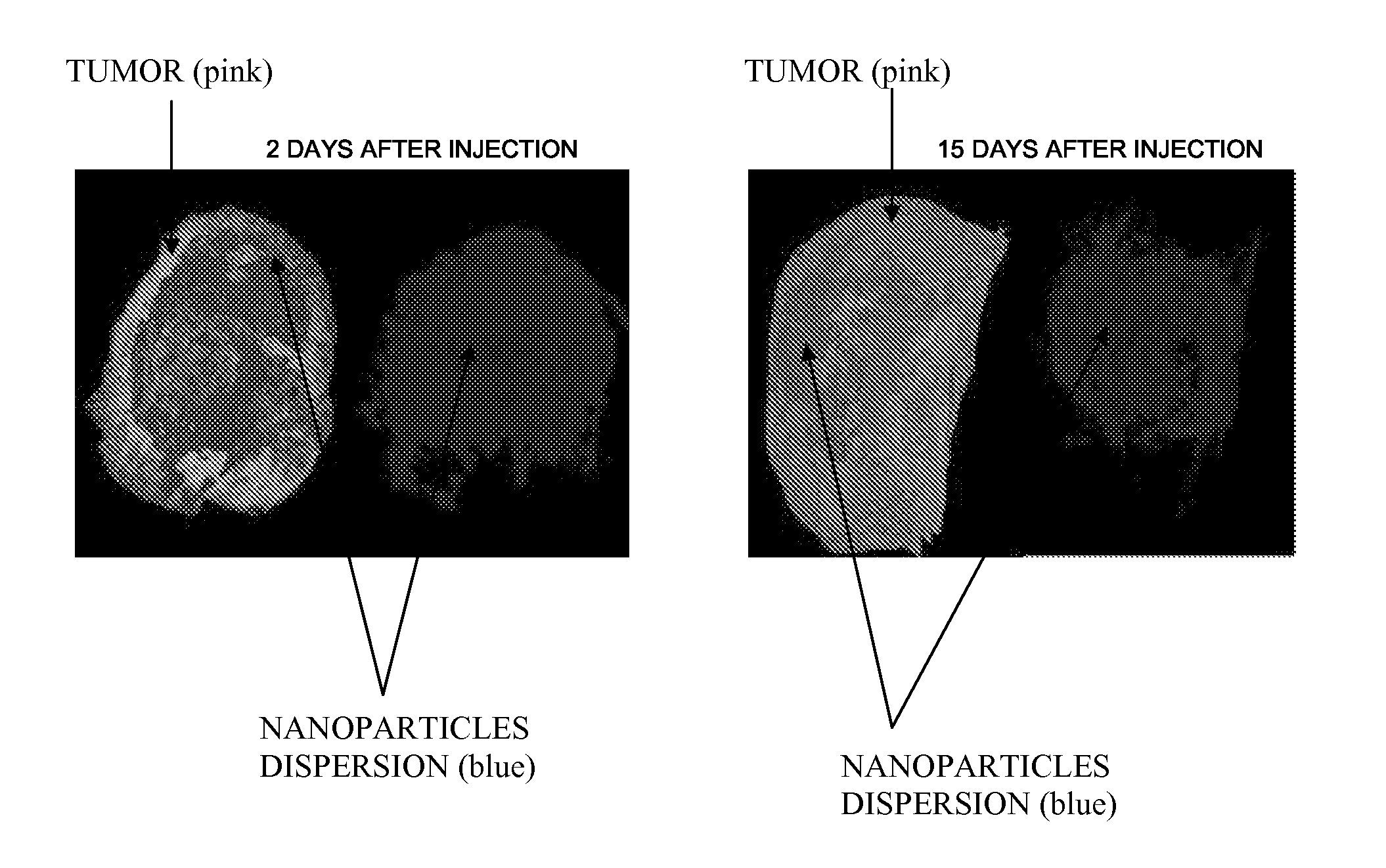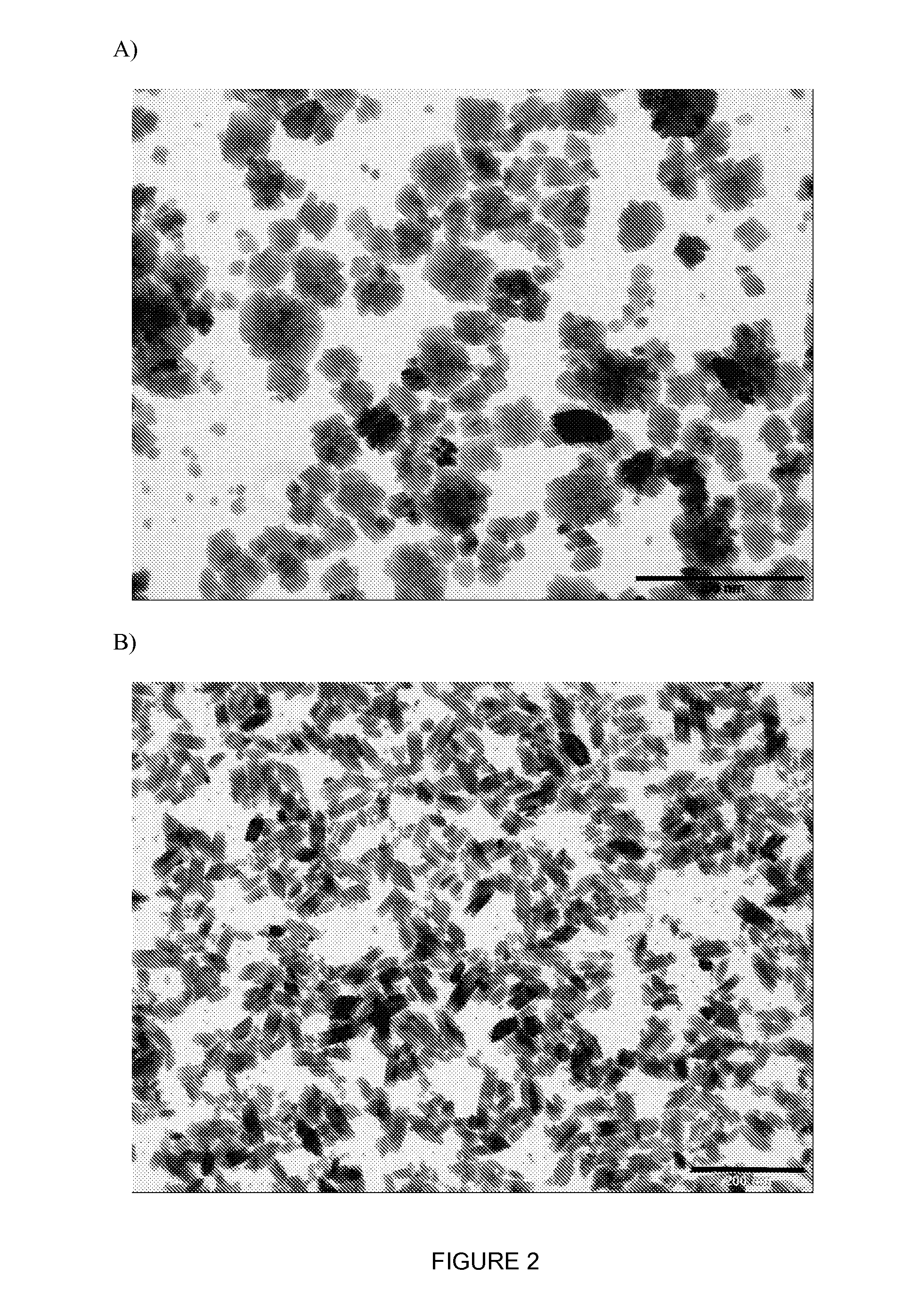Inorganic Nanoparticles of High Density to Destroy Cells In-Vivo
- Summary
- Abstract
- Description
- Claims
- Application Information
AI Technical Summary
Benefits of technology
Problems solved by technology
Method used
Image
Examples
example 1
[0285]Biocompatible suspension of hafnium oxide (HfO2) nanoparticles or nanoparticle aggregates with a density above 7 g / cm3, using sodium trimetaphosphate as cating agent.
[0286]A Tetramethylammonium hydroxide (TMAOH) solution is added to 40 g of HfCl4 solution. Addition of TMAOH solution is performed until the pH of the final suspension reaches a pH comprised between 7 and 13. A white precipitate is obtained.
[0287]The precipitate is further transferred in an autoclave and heated at a temperature comprised between 120° C. and 300° C. to perform crystallization. After cooling, the suspension is washed with de-ionized water.
[0288]A peptization step, is performed in order to get a stable suspension of nanoparticles or nanoparticle aggregates.
[0289]Suspension of Sodium trimetaphosphate is then added to the peptized solution (the amount of sodium trimetaphosphate added being below lethal dose (LD) 50 / 5) and the pH of the suspension is adjusted to a pH comprised between 6.5 and 7.5.
[0290]...
example 2
[0293]Biocompatible suspension of hafnium oxide (HfO2) nanoparticles or nanoparticle aggregates with a density below 7 g / cm3, using sodium trimetaphosphate as coating agent.
[0294]A Tetramethylammonium hydroxide (TMAOH) solution is added to 40 g of HfCl4 solution. Addition of TMAOH solution is performed until the pH of the final suspension reaches a pH comprised between 1 and 5. A white precipitate is obtained.
[0295]The precipitate is further transferred in an autoclave and heated at a temperature comprised between 120° C. and 300° C. to perform crystallization. After cooling, the suspension is washed with de-ionized water.
[0296]A peptization step, is performed in order to get a stable suspension of nanoparticles or nanoparticle aggregates.
[0297]Suspension of Sodium trimetaphosphate is then added to the peptized solution (the amount of sodium trimetaphosphate added being below LD50 / 5) and the pH of the suspension is adjusted to a pH comprised between 6.5 and 7.5.
[0298]For in vitro ex...
example 3
[0301]Biocompatible suspension of hafnium oxide (HfO2) nanoparticles or nanoparticle aggregates with a density above 7 g / cm3, using sodium hexametaphosphate as coating agent.
[0302]A Tetramethylammonium hydroxide (TMAOH) solution is added to 40 g of HfCl4 solution. Addition of TMAOH solution is performed until the pH of the final suspension reaches a pH comprised between 7 and 13. A white precipitate is obtained.
[0303]The precipitate is further transferred in an autoclave and heated at a temperature comprised between 120° C. and 300° C. to perform crystallization. After cooling, the suspension is washed with de-ionized water.
[0304]A peptization step, is performed in order to get a stable suspension of nanoparticles or nanoparticle aggregates.
[0305]Suspension of Sodium hexametaphosphate is then added to the peptized solution (the amount of sodium hexametaphosphate added being below LD50 / 5) and the pH of the suspension is adjusted to a pH comprised between 6.5 and 7.5.
[0306]For in vitr...
PUM
| Property | Measurement | Unit |
|---|---|---|
| Size | aaaaa | aaaaa |
| Size | aaaaa | aaaaa |
| Density | aaaaa | aaaaa |
Abstract
Description
Claims
Application Information
 Login to View More
Login to View More - R&D
- Intellectual Property
- Life Sciences
- Materials
- Tech Scout
- Unparalleled Data Quality
- Higher Quality Content
- 60% Fewer Hallucinations
Browse by: Latest US Patents, China's latest patents, Technical Efficacy Thesaurus, Application Domain, Technology Topic, Popular Technical Reports.
© 2025 PatSnap. All rights reserved.Legal|Privacy policy|Modern Slavery Act Transparency Statement|Sitemap|About US| Contact US: help@patsnap.com



